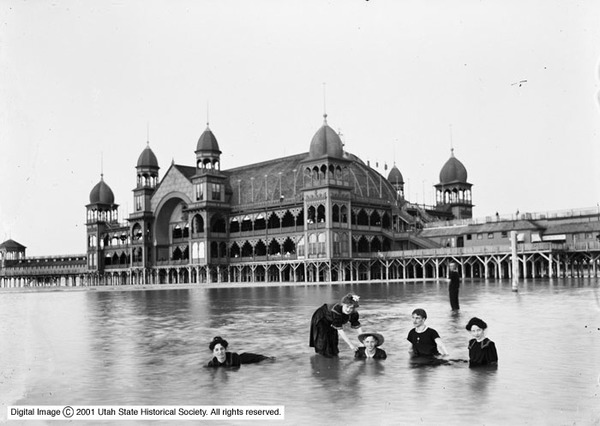Dublin Core
Title
Description
Great Salt Lake’s high salt content and squirmy brine shrimp make it a less-than-ideal swimming hole for many Utahns. However, the lake saw more than its fair share of resorts throughout the late 1800s, including the famously popular Saltair. Located only a short train ride from Salt Lake City, the resort’s owners capitalized on the growing demand for recreation and leisure at the briny waters of Great Salt Lake.
Saltair opened on Memorial Day 1893. Designed by renowned architect Richard Kletting, the resort’s impressive design embraced its location on “America’s Dead Sea'' by appropriating a distinctly Moorish style. Saltair boasted large onion domes, ornamental arches, and expansive pavilions. The dramatic structure dazzled on the southern shore of Great Salt Lake. Although the resort was just a short distance from the city, Saltair embraced its image as an exotic-feeling recreational destination. And the main attraction, of course, was the lake’s salty water.
Thanks to Great Salt Lake’s high salinity, bathers could “bob around like corks” in its warm waters during the summer months. Swimmers who lacked appropriate gear to get in the lake could rent swimming suits and towels for ten cents. As if floating in a dead sea was not enough of a draw, the resort also advertised the so-called healing properties of soaking in the briny waters. Other, more adventurous bathers, embraced the windy environment of the lake and fashioned personal wind sailing devices to move themselves across the surface.
The Saltair resort was a huge success until a series of fires and natural calamities in the 1920s and 30s ultimately destroyed the buildings. In the years following World War II, surrounding communities used the lake as a dumping ground and contaminated the waters with sewage. By then, the exoticism of America’s Dead Sea had lost most of its appeal, and resort goers flocked to the cleaner waters of Lagoon, on the lake's east shore. At its peak, the inland lake attracted nearly a half-million visitors per year. But, today, Great Salt Lake is at record a low water level and very few Utahns are brave enough to float among the brine shrimp.
Creator
Source
_______________
See John D. C. Gadd, “Saltair: Great Salt Lake’s Most Famous Resort,” Utah Historical Quarterly 36 (1968); John S. McCormick, “Saltair,” Utah History To Go, 1994; The Saltair, “History of the Saltair”; “Saltair: A Photographic Exhibit,” Utah History To Go; Addison Blaire, “Saltair: The Coney Island of the West,” Intermountain Histories, April 3, 2017; “Resorts Flourished at Great Salt Lake During the 1800s,” Deseret News, March 28, 1998.

